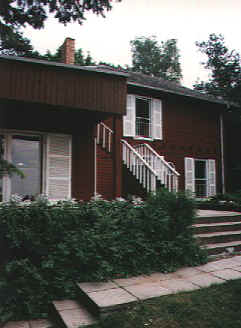“… the young architect Konrad Wachsmann began his journey in Niesky, Lower Silesia to
Berlin intending to build a house for the great physicist Albert Einstein.”
From Albert Einstein in the World Wide Web (www.einstein-website.de)
Short life history: Konrad Wachsmann
* May 16, 1901 Frankfurt (Oder), † November 25, 1980 Los Angeles
The architect Konrad Wachsmann was born to Jewish parents in Frankfurt (Oder) on May 16, 1901. After an apprenticeship as carpenter he studied in Berlin at the College of Art and in Dresden at the Academy of Arts from 1920 to 1924. After that he was student of the German constructor Hans Poelzig (1869–1936) in Berlin and Potsdam who was one of the main representatives of expressionistic architecture in Germany. Wachsmann was chief architect with the back then greatest wood construction company in Europe, Christoph & Unmack AG in Niesky, Lower Silesia from 1926 on.

He developed an industrial prefabricated wood construction system for single family houses in 1925 whose most famous product is the summer house of Albert Einstein (1879–1955) in Caputh near Potsdam.

“In spring 1929 Konrad Wachsmann got to know of the birthday present of the city of Berlin to Albert Einstein (50th birthday) and that Einstein in this connection was interested in a wood house. Thus he went to Berlin to Haberlandstrasse 5 and offered Einstein to build this house for him. After some conversations with Einstein and numerous construction proposals Wachsmann received the order to build the house. About the same time he resigned with the company Christoph and Unmack and afterwards worked as a freelance architect. Einstein and Wachsmann got along with each other very well right from the beginning and Wachsmann later became a very welcomed guest with the Einstein’s in Caputh.”
(From Albert Einstein in the World Wide Web)
Wachsmann received the Rome Prize of the Prussian Academy of Arts in 1932. It entitled him to work artificially and free of charge for one year at the German Academy in Rome, in Villa Massimo. Einstein – who had been living in the United States for years – helped Wachsmann in 1941 to emigrate to the United States as well.
In the 40ies Wachsmann worked with the architect Walter Gropius (1883–1969) and together they developed the general-panel-system (prefabricated house system) through which Wachsmann also gained international glory.
He taught at the Institute of Design in Chicago from 1949 on and later at the University of Illinois. He changed to the University of Southern California in Los Angeles in 1964 where he worked until he conferred emeritus status in 1974. In this time he worked – among other things – on the further development of construction systems for self-supporting halls, structural engineering and their mass production.
On the occasion of Albert Einstein’s 100th birthday in 1978/79 he helped with the restoration of Einstein’s former summer house in Caputh. Konrad Wachsmann died at the age of 79 in Los Angeles in November 1980, buried according to his own wish in his home town Frankfurt (Oder).
Illustrations Credits:
Courtesy of the Stiftung Archive der Akademie der Künste, Berlin, Konrad-Wachsmann-Archiv, Signatur: KWA-20-4: 1
Courtesy of the Community of Caputh, Copyright by Hans-Josef Küpper: 2


 DEUTSCH
DEUTSCH